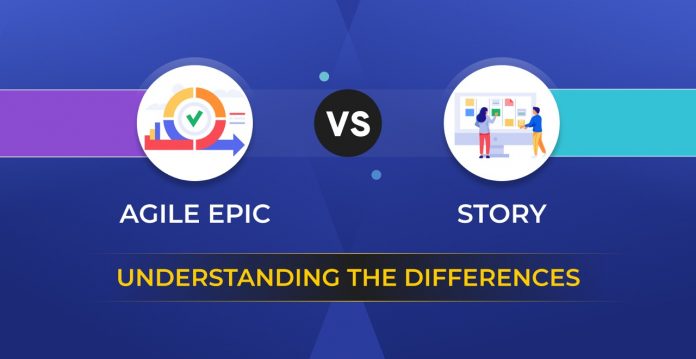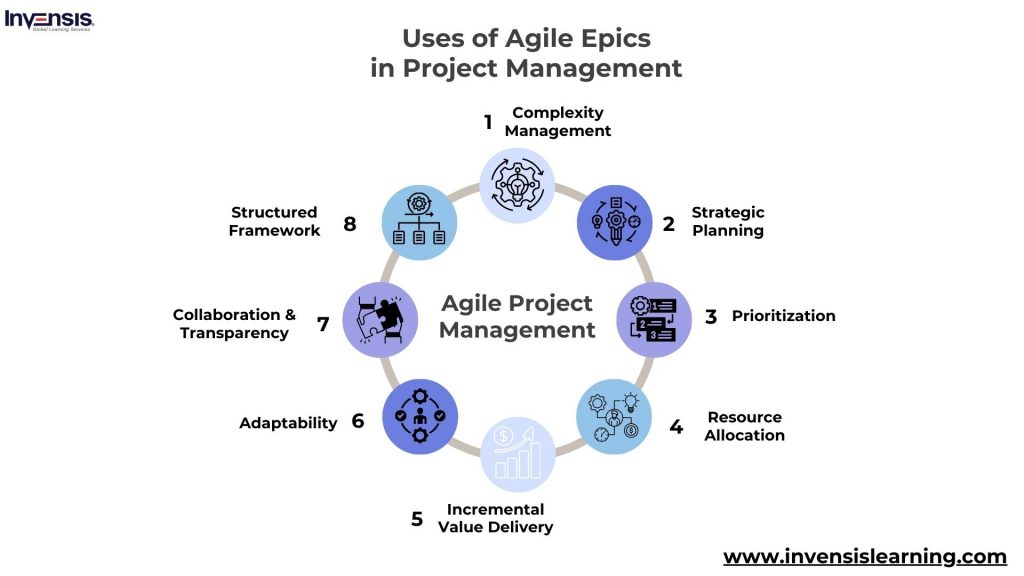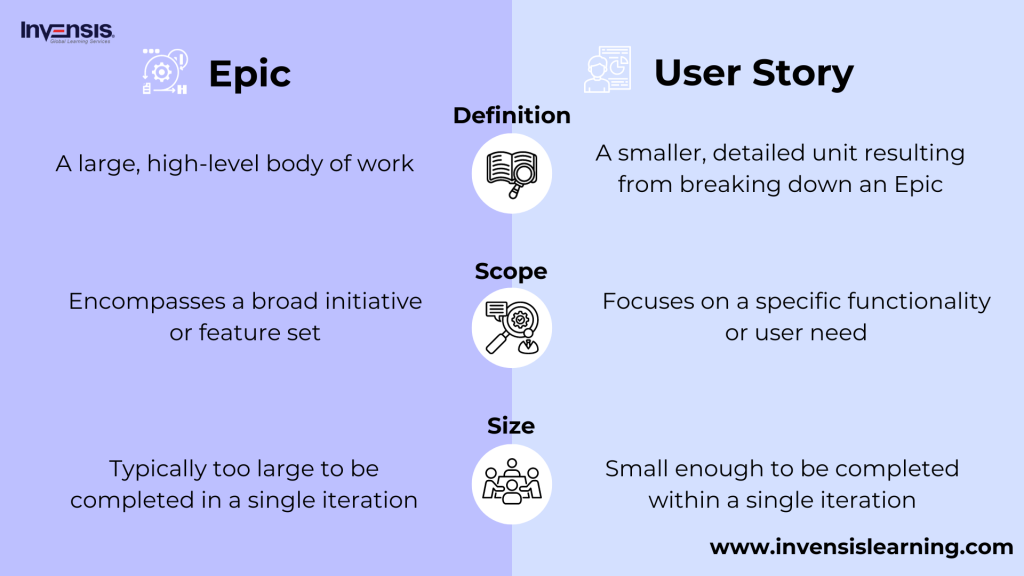
When managing a project, especially in Agile, you’ve likely come across terms like “Epic” and “User Story.” But what do they actually mean, and how do they differ? Understanding these two concepts is key to breaking down complex tasks and delivering value effectively.
In simple terms, an Epic is a large chunk of work that can be broken down into smaller, manageable pieces, while a User Story represents those smaller, actionable tasks. Think of an Epic as a high-level idea or goal and User Stories as the steps needed to achieve that goal.
For teams to work smoothly, it’s important to distinguish between these two and know when to use each. This blog dives into their definitions, key differences, and how they complement each other. Additionally, we’ll provide clear examples to help you visualize these concepts in action.
Table of Contents:
- What is an Epic in Agile?
- Why are Agile Epics Used?
- Example of Agile Epics
- What are User Stories?
- Example of User Stories
- Epic vs User story
- Conclusion
What is an Epic in Agile?
In Agile methodology, an epic is a large and complex body of work that can be deconstructed into smaller tasks, known as user stories. Epics are used to organize and categorize work, providing a high-level view of the project requirements. Typically, epics are too large to be completed in a single iteration and are broken down into smaller, more manageable user stories.
Epics serve as a means to capture and convey the overall scope of a feature or a set of related features. They act as placeholders for the detailed user stories that will be created during the planning and execution phases of an Agile project. Epics play a crucial role in facilitating a structured and iterative delivery of value, providing a strategic framework for achieving project goals.
What are Agile Epics Used for?
Agile epics play a crucial role in the Agile methodology, addressing the complexities of large-scale initiatives and offering a strategic roadmap for development teams. Using Agile epics brings several advantages in project management, enhancing the effectiveness of Agile methodologies.
Here are a few areas where Agile epics are required:
- Complexity Management: Agile epics help teams tackle the complexities of extensive tasks by breaking them down into smaller, more manageable components
- Strategic Planning: As a strategic planning tool, epics guide the team in prioritizing tasks and aligning them with the overall project vision
- Prioritization: Epics aid in prioritizing work, allowing teams to focus on delivering high-value components first, ensuring maximum impact
- Resource Allocation: By breaking down tasks, Agile epics facilitate efficient resource allocation, ensuring team members contribute effectively to project objectives
- Incremental Value Delivery: Breaking epics into smaller user stories enables teams to deliver incremental value to end-users in a phased and iterative manner
- Adaptability: Agile epics support adaptability by allowing teams to adjust priorities and respond promptly to changing requirements without compromising the project roadmap
- Collaboration and Transparency: Epics foster collaboration and transparency within the team, ensuring everyone understands the strategic direction and goals of the project
- Structured Framework: Providing a structured framework for development, Agile epics enable teams to work towards common objectives and milestones
Agile epics serve as a foundational element in Agile project management, offering a structured approach to planning, communicating, and executing large-scale initiatives.
Example of Agile Epics
In the context of Agile project management, an Epic is a large, overarching body of work that represents a significant feature, theme, or initiative within a project. Epic is a large and complex body of work that can be deconstructed into smaller tasks, known as use stories. User stories, in turn, are specific and actionable tasks that contribute to the completion of the overall Epic.
Here’s an Agile epic example:
Agile Epic: Task Management Upgrade
Within the overarching project goal of enhancing task management features, the epic “Task Management Upgrade” encompasses various functionalities to optimize how teams plan, organize, and track tasks within the project management tool.
User Stories within the Epic:
- Customizable Task Boards
As a project manager, I want to create customizable task boards that align with our workflow, allowing teams to visualize and manage tasks through different stages seamlessly
2. Task Dependencies
As a team lead, I want the ability to establish dependencies between tasks, ensuring that the completion of one task starts or the completion of another for improved project scheduling and coordination
3. Advanced Filtering and Sorting
As a team member, I want advanced filtering and sorting options for tasks, enabling me to quickly locate and prioritize tasks based on criteria such as due date or priority
4. Task Progress Tracking
As a stakeholder, I want a visual representation of task progress, including charts or graphs that provide insights into completion rates and potential back-ups, facilitating better decision-making
5. Integration with Calendar Tools
As a user, I want tasks to seamlessly integrate with popular calendar tools, allowing me to view and manage project timelines alongside my other commitments for improved time managementThis Agile epic, “Task Management Upgrade,” serves as a container for these user stories, guiding the development team in enhancing the task management capabilities of the project management tool.
What are User Stories?
In software development and product management, a user story is an informal narrative describing software features from an end-user perspective. Used in Agile methodology, it outlines user type, needs, and reasons, simplifying requirement descriptions.
User stories are recorded on cards, post-it notes, or project management software and may be written by various stakeholders. They embody an agile approach by shifting focus from written to verbal discussions about requirements. Each user story includes a concise written statement and crucial conversations about the desired functionality.
This tool fosters collaboration among clients, users, managers, and development teams, contributing to the iterative nature of Agile development. User stories are integral to capturing detailed software features in a user-centric and adaptable manner.
Example of User Stories
When discussing Agile methodology, it’s important to understand the different components that make it effective. A key aspect of this methodology is its focus on breaking down work into manageable units.
In this section, we’ll understand an example of user stories in Agile, which are small, focused tasks or features that contribute to the larger goals of a project, often represented by epics.
These stories provide clarity, simplicity, and a user-centric perspective, essential for efficient and successful project execution in an Agile environment.
-
Task Creation
As a user, I want to create a new task with a title, description, and due date so that I can organize and manage my work effectively.
-
Task Assignment
As a project manager, I want the ability to assign tasks to specific team members, ensuring clear responsibility and accountability within the team.
-
Task Prioritization
As a user, I want to prioritize tasks by setting their importance or urgency, allowing me to focus on high-priority items and efficiently meet deadlines.
-
Task Status Updates
As a team member, I want to update the status of a task (e.g., in progress, completed) to provide real-time visibility into the project’s progress.
-
Notifications
As a user, I want to receive notifications or reminders about upcoming task deadlines or any changes in task assignments to stay informed and on track.
These user stories address specific functionalities of the task management application from the perspective of different users, enabling the Agile development team to deliver features incrementally and iteratively based on user needs and priorities.
Epic Vs. User story
Epics and User Stories are foundational concepts in Agile project management, each serving a distinct purpose. An Epic represents a large, high level body of work encompassing a broad initiative or feature set. It provides an overarching view of project requirements and goals, acting as a roadmap for the team. However, due to its size and complexity, an Epic is typically too large to be completed within a single iteration or sprint. For example, an Epic might involve developing an entire “User Onboarding Process” for an application, covering multiple functionalities and tasks.On the other hand, a User Story is a smaller, detailed unit of work derived from breaking down an Epic. Focused on specific functionalities or user needs, User Stories are actionable tasks that can be completed within a single sprint. They are user centric and aim to deliver incremental value to the end user. For instance, a User Story under the “User Onboarding Process” Epic could be, “As a user, I want to reset my password so that I can regain access to my account.” Together, Epics and User Stories help Agile teams balance strategic planning by executing detailed, user focused tasks and ensuring smooth and efficient project delivery.
Here’s a simple table outlining the key differences between epics and user stories in Agile project management:
Conclusion
Distinguishing between Agile epics and user stories is vital for effective project management. Epics provide a high-level vision, guiding teams strategically, while user stories offer detailed functionalities for incremental development. This understanding empowers Agile teams to balance comprehensive project goals with manageable granularity, fostering enhanced project success.
The example of “Task Management Upgrade” demonstrates how epics serve as containers for specific user stories, showcasing their collaborative role in Agile methodology. Ultimately, recognizing the importance of epics and user stories is key to achieving success in Agile project management.
For those seeking expertise in Agile project management, Invensis Learning’s Agile Project Management Courses are valuable, imparting comprehensive knowledge for managing projects with flexibility and responsiveness in the rapidly changing software development environment.















